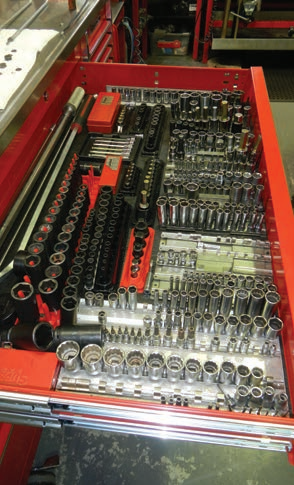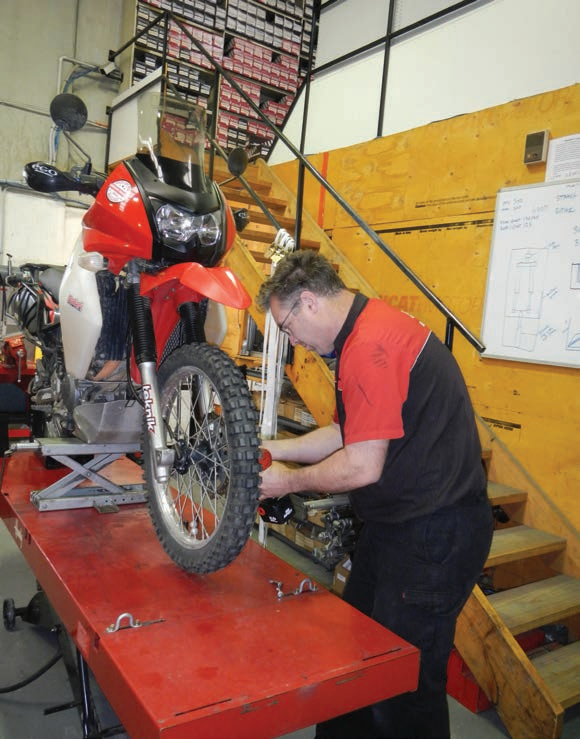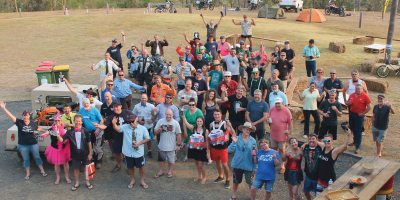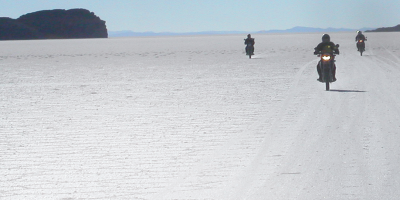- Bianca Pollard
- It’s What We Do
- The Congregation
- Great Rides Volume 3:North-west NSW
- Industry Players:Matt Phillpott
- Armour
- Hard-pannier Hard men
- Shop Bike
- Cambodia:Temple Central
- Trophy Hunter
- Chris Birch
- Cannonball Lima Cali
- Bright to The Gulf
- Picture This
- How To Ride with Miles Davis
- Adventure Travel Film Festival
- Miles of Smiles with Karen Ramsay
- Checkout
- Fit Out
Adventure Rider Magazine’s KLR650 headed back to the Teknik Motorsport workshop for a little more suspension work.
It’s been a while since we had a look at the office 2009 KLR.
Last we saw of it was a fading plume of dust as it roosted effortlessly down the Finke Access Road near Alice Springs. The editor and publisher, up to their knees in the talcum-powder dust, held back tears and nursed their bikes – both with clutches destroyed – as the publisher’s brother-in-law kept the throttle pinned and the KLR disappeared into the distance (see issue #12).
It was the boss’ brother-in-law after all, so nobody was too worried when the bike sort of disappeared for a while.
The bike eventually reappeared, none the worse for charging from Alice Springs across to the coast, and settled in to its usual spot in the Adventure Rider Magazine shed.
No one paid it much attention.
It didn’t need a new clutch, or major maintenance, or even minor maintenance.
As usual, the bike looked ready to tackle anything, even though it’d just finished tackling just about everything.

Value ad
While all this was going on, Adventure Rider Magazine’s newest staffer, ad manager Mitch Newell, was getting stuck into his work routine and, being a motocrosser, wasn’t being invited on any rides. His bike was a motocrosser too, and when he did go out with anyone he spent all his time asking whether they could get away from a standing start faster with or without traction control, and whether when they climbed up over the front of the bike and hung the back out in corners, all the crash bars and lighting made the powerslide hard to manage.
Poor, friendless, Mitch.
Then the boss had one of his brainwaves.
“Let’s put Mitch on the KLR for while,” he brained. “He can start with a run up to the Congregation,” he said, waving in a generally northern direction.
And so it came about that Mitch, who’s a bit of a boofer size-wise, took charge of the shop bike and set about learning some of the joys of adventure riding.

Miles ahead
The lesser horsepower combined with 100kg or so extra mass compared to his YZ250F soon had the advertising executive reassessing lots of things, but he hit some good luck almost immediately. His first couple of outings were in the company of BMW Motorrad’s Miles Davis. There couldn’t be a better riding partner for a newbie of any age, let alone – let’s be delicate – an ‘aging’ rider who’s only just got his Learners’ permit (snigger). Sure enough, Miles was able to offer some great insight into a sensible adjustment of philosophy and technique. The best facets of Mitch’s motocross background were retained and put to good use on the slower, heavier adventure bike.
Mitch still insisted on jumping every frigging thing until he broke off a footpeg, but that’s by the by. There were some sensible things that needed to be dealt with to keep the mighty KLR doing its thing.
The bike was rolled back into the Teknik Motorsport workshop and Nick Dole went to work.

Good deal
Just to recap, because it’s been a while since this bike had any attention, Nick’s original suspension set-up on the KLR was to suit the publisher, 100kg of happy, sight seeing adventurer. At the same time, the KLR was being prepared for a run at ADVX with the editor, who weighed a little less, but was going to carry a huge lump of fuel and luggage, so it sort of evened out.
Now the rider is 100kg of lithe, lunging, love-muscle – he made us write that – and the bike was copping a bit of a hammering. Nick still had one suspension ace up his sleeve for the Kwaka: V4S valves.With the bike up on the hoist, Nick had the forks out in about five minutes and in a few minutes more had them dismantled, measured, and ready for some attention.

Bouncer
The aim of the exercise on this occasion was to fit Teknik V4S valves.
The KLR uses a damper-rod fork. The V4S will make the KLR front end more like a cartridge fork, offering better control of the fork-leg oscillation (for those of us without an engineering background, that’s means how fast the fork legs move up and down).
We thought Nick would just pop the fork caps, drop the valves in, then send us on our way, but it proved to be quite an involved process. Nick was happy to share with us the work he’d done, knowing full well we wouldn’t understand any of it.
“I had to machine the four eight-millimetre holes in the bottom of the damper rod,” explained the eternally patient technician. “I drilled them out to 10mm. That’s pretty much a standard procedure when you’re putting any sort of speed-sensitive damping device into a damper-rod fork.
“Seeing as I was doing a bit of work to the damper rods, I welded up the rebound holes because the rebound on that fork was reasonably fast. I also took a small cut off the top of the V4S valve and bored out the top of the damper rod a bit, just so the valve’s a better fit.”
Crikey. We thought it was going to be a simple job.
But Nick wasn’t finished yet, and we breathed a sigh of relief at his meticulous record keeping. He knew exactly what had been done to the bike, top to bottom, since we first took it to him.
“Because the valve was 12mm high and I was happy with the spring preload from the first stage of working on this bike, I took 12mm off the preload tube. So the preload stayed the same, we still have the same 7.5-weight oil 130mm from the top, and the we left the same .54-weight fork springs we fitted at the first stage.
The result Nick’s aiming for is that the front wheel won’t seem as ‘busy’.
“It won’t feel as though the front wheel is constantly moving, pulling on the rider’s hands and wrists. The feeling I’m talking about is often described by people as ‘harsh’, but what they’re feeling is the front wheel constantly moving around because it’s under-damped. Their perception is that they have too much damping and they feel they need to make it softer, when in fact what’s happening is the wheel is oscillating too fast. The V4S valves will help control that oscillation and the bike will be more stable.”
 The forks were removed, serviced and had Teknik V4S valves fitted.
The forks were removed, serviced and had Teknik V4S valves fitted.
But wait. There’s more!
While the forks were being attended to there were a couple of other concerns that needed looking at, and we’re not so dumb as to be in a workshop like that one, with a technician of that calibre, and not take advantage of the situation.
The needle in the carby had been jamming and piddling fuel out all over the place, so the float bowl was removed, the seat cleaned with valve-grinding paste on the end of a cotton bud, and a new needle and clip put in place. The needle seat on the KLR carby isn’t a replaceable part.
The bike had also been going through a fair amount of oil on long road sections. It’s been a KLR trait in years past, but we thought we’d ask Nick to have a look at the compression and give us his opinion.
He gave us his opinion of compression tests, and it wasn’t high.
Instead, he bolted up some technical-looking kit and did a ‘leak-down’ test.
Instead of saying, “Yeah. Compression’s a bit how’s-your-father, eh?” the leak-down test establishes where in the system pressure is being lost.
“We put 100psi of air in the cylinder above the piston, rotate the crank so the inlet and exhaust valves are closed, and then measure the percentage of air that leaks out,” explained Nick. “We can also pinpoint where the pressure is being lost.”
The KLR had about 20 per cent leakage, and Nick felt, given the engine’s age and use, that it was a little high, but no real problem.
He was less impressed with the state of the air filter as we tried to sniggle it away before he saw it, but we don’t need to dwell on things like that.
 There seem to be a lot of pics of Mitch leaning on machinery while other people are working.
There seem to be a lot of pics of Mitch leaning on machinery while other people are working.
Moving on
After a fun day in the workshop (for us, at least, and Ernie, Nick’s ball-fetching dog), the KLR’s suspension is now about as good as it can reasonably get without spending an excessive amount.
“What limits those stock forks is their physical size,” said the Grand Poobah of suspension. “I think they’re a 41mm fork leg.
That’s the same as we used to run on XR250s, and they weighed something like 50kg less.
“This is as far as I’d recommend anyone goes with the standard KLR suspension components.
So there it is.
Let’s see how it shapes up in the real world with Mad Mitch the Motocrosser on board.
We’ll let you know.















Comments